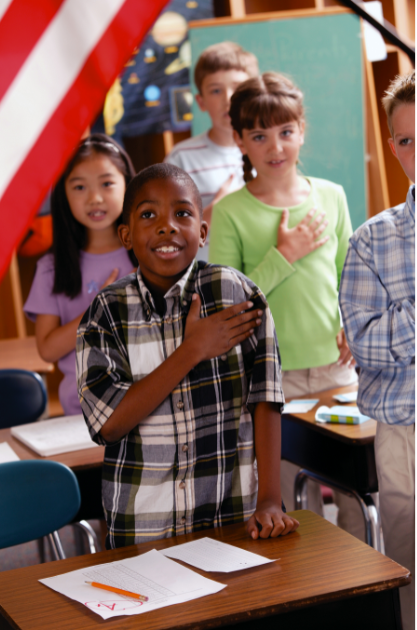When James Damore sent his inaccurate and problematic memo on diversity in the workplace, the internet, tech experts, and the general world responded with justified frustration.
Photo by Leon Neal/Getty Images
The former Google software engineer wrote a 10-page anti-diversity memo in which he claimed the gender gap in tech is due to biological differences between men and women, rather than discrimination. And, while Damore did not directly ascribe to a political party, he compared being conservative today to being gay in the 1950s.
Damore's comments echoed what staffers of color and women in a variety of STEM-focused careers have heard repeatedly in predominantly white offices and schools: They don't belong here.
Still, they continue to prove naysayers wrong through their hard work, dedication, and brilliance.
Simply look at a tech conference, the launch of a millennial-focused website, or a new startup initiative to find women and people of color changing the face of tech in innovative and influential ways — in spite of working with and often being educated by people like Damore.
Here are seven badass people of color changing the game for minority groups in tech.
1. Tristan Walker, founder and CEO of Walker & Company Brands, Inc. and CODE2040
Tristan Walker speaks at TechCrunch. Photo by Noam Galai/Getty Images for TechCrunch.
Walker & Company Brands, Inc., is a grooming products company for African-Americans, and CODE2040 is an organization dedicated to providing tech pathways in the innovation economy for black and Latinx people. Through these ventures, Walker has used his business and tech savviness to create businesses and organizations by and for people of color.
Walker often speaks at conferences to discuss the importance of teaching tech in schools and communities of color, and he advocates for increasing the number of women and people of color in tech.
2. Ruzwana Bashir, founder and CEO of Peek.com
After graduating from Oxford and Harvard Business School, Ruzwana Bashir worked in investment banking before creating Peek, an online platform for vacation planning. The U.K. native of Pakistani descent has had profound influence in the tech industry, and she's used her voice to speak out against sexual assault and abuse.
Photo by Slaven Vlasic/Getty Images for the 2015 Tribeca Film Festival.
3. Khalia Braswell, UI/UX designer at Apple and founder of INTechCamp
According to a report from National Center for Women & Information Technology (NCWIT), black women only hold 3% of computing jobs. Khalia Braswell is one of the many faces in the competitive STEM field working to change this. The Apple UX designer founded INTech Camp in 2014, aiming to expose more girls of color to technology and to increase gender and racial representation in tech in future years.
"Being future ready means building relationships, remaining positive, and giving back to those that helped you along the way," Braswell said in a speech for NAF (formerly the National Academy Foundation). Braswell maintains an active social media presence and continues to work with young girls in her nonprofit.
4. Elaine Warren, founder of SurvivorPlan
The innovative technology veteran has worked with business and health care clients, such as Emory University and Veterans Health Administration, for 20 years to provide software solutions for their initiatives.
"I loved the creativity along with the structure, and I realized that software development was both a science and an art form," Warren told Redox. "I went on to study computer science in college and was hooked."
Warren earned her master's degree in computer science and is now the leader of Survivor Plan, a company that works to provide personalized solutions for cancer survivors, their clinicians, and their loved ones.
5. Evelyn Miralles, principal engineer and virtual reality innovator at NASA
Miralles is known as a a pioneer of virtual reality at NASA. Her career, spanning 25 years, has influenced women around the world. She is one of many Latina women who have paved the way for more opportunities for women and people of color in science and technology.
Miralles was on the BBC World 100 Women list, CNET's Top 20 Latinos in Technology list, and is a distinguished alumna of University of Houston Clear Lake.
6. Clennita Justice, senior engineering program manager at Google
Clennita Justice, a former Apple employee, has worked on a variety of projects at Google, including assisting with launching Google Play Books (formerly Google Books).
“I’m always doing something around my own personal development, and I’ve always thought of technology as a means for helping us be better people and have better lives, enjoy our lives, and increase our self-awareness,” Justice told Google Careers.
Justice now works in product strategy to manage an in-product tool designed to complete surveys to asses user satisfaction. She is also a member of Black Googles Network (BGN), an organization that serves as a resources for Black "Googlers" and allies.
7. Morgan DeBaun, co-founder and CEO of Blavity
Morgan DeBaun at TechCrunch. Photo by Steve Jennings/Getty Images for TechCrunch.
Morgan DeBaun is the co-founder and CEO of Blavity, a website dedicated to black millennials. The Forbes 30 Under 30 alumna saw a need for a content space created by black people, so she left her job and used her tech skills and business knowledge to create a website that constantly produces viral, relevant content for her audience.
She has also worked to create spaces for black people and women in tech, including AfroTech, the largest black tech conference in Silicon Valley.
These seven are just a handful of examples of the numerous men and women of color innovating and changing the future of technology. It's imperative we continue creating opportunities for diversity in our elite school systems and the workplace.




 American portion sizes are colossal.
American portion sizes are colossal. Tax shouldn't be a not-so-fun surprise at the end of your shopping trip.
Tax shouldn't be a not-so-fun surprise at the end of your shopping trip.  A trip to the doctor shouldn't break the bank.
A trip to the doctor shouldn't break the bank. This totally isn't weird at all. Right?
This totally isn't weird at all. Right? It's a choice.
It's a choice.  America loves extra sugar in savory foods.
America loves extra sugar in savory foods.
 Princess Odette Girl GIF by The Swan Princess
Princess Odette Girl GIF by The Swan Princess  Rose GIF
Rose GIF  sailor moon GIF
sailor moon GIF  river phoenix 80s GIF
river phoenix 80s GIF 
 All of this will be ours one day. Yay.
All of this will be ours one day. Yay.  Elderly woman with white hair on phone, sharing a story about a dead person her child has never met.
Elderly woman with white hair on phone, sharing a story about a dead person her child has never met.  Surprised elderly man in blue shirt against a yellow background.
Surprised elderly man in blue shirt against a yellow background. Elderly woman in pink shirt using a smartphone on a garden swing.
Elderly woman in pink shirt using a smartphone on a garden swing. TV for waking. TV for sleep.
TV for waking. TV for sleep.  Elderly man using a magnifying glass to read a piece of mail
Elderly man using a magnifying glass to read a piece of mail
Mom is totally humiliated after her kindergartner tells the teacher what she does for work
She was clearly mortified.
A mom is embarrassed by her child.
One of the great joys and stresses of parenting is that you never know what will come out of your child’s mouth. When you have young, inquisitive kids, they can say really inappropriate things to people without realizing they were being rude or possibly offensive. TikTok influencer Aurora McCausland (@auroramccausland), known for her DIY cleaning tips, recently told a funny story on the platform about how her son believes she makes a living. The problem was that she heard about it from her child's teacher.
Mom is embarrassed by her child
“The other day, I went and picked my five year old up from school and when I get to his classroom his teacher pulls me inside and says, ‘Hey, today he wanted to tell us about what Mommy does for work and said that Mommy makes videos in her bedroom but only when I'm [he’s] not at home,” McCausland recalled.
Given her body language while telling the story, McCausland was clearly mortified after hearing what her child said to his teacher. It makes it look like she may be posting videos to adult sites while her child is at school, which most people wouldn’t want their son’s teacher to know about.
The good news is that another teacher was there to clarify the young boy's comments by adding, “I think she makes TikTok videos.” The uncomfortable situation was a great invitation to chat with her son about what she does for a living. “So I have to have a conversation with my son about how he tells people what I do for work,” she finished her video.
The funny video went viral, earning over 1.7 million views on TikTok, and inspired many people to share the times when their children had funny ways of explaining their careers. The commenters were a great reminder to parents everywhere that if your child says something embarrassing, it's ok, just about everyone has been through it.
Moms share their most embarrassing moments
A lot of parents spoke up in the comments to show McCausland that she's not the only one to feel embarrassed in front of her child's teacher.
"My son told everyone that we were homeless (because we don’t own our home, we rent)," KBR wrote.
"I work in ortho.. my daughter told her teacher I steal people's knees bc she heard me talking to my husband about a knee replacement," Aingeal wrote.
"My son told a teacher we were living in our car over the summer. Camping. We went camping," Kera wrote.
"In kinder, my son thought Red Bull was alcohol and told his teacher I liked to have beer on the way to school," Ashley wrote.
My niece told her teacher her mom and dad work at the wh*re house. They work at the courthouse," Ellis wrote.
"My husband works as a table games dealer at a casino. Kindergartener, 'Daddy's a Dealer!' We now start every school year clearly stating he works at the casino," CMAC
"My son said we lived in a crack house…There’s a tiny chip in the wall from the doorknob," KNWerner wrote.
"My dad is a hospice chaplain and officiates a lot of funerals. My son and nephew were asked by their preschool teacher if their papa was retired or had a job. They told her his job was to kill people," Tiffyd wrote.
"My son said "my dad left me and I'm all alone" to a random person at the zoo. My husband was just at work," Shelby.
"I am now in my 70s. In my gradeschool, during the McCarthy era, I told my teacher my dad was a communist. He was an economist," Crackerbelly wrote.
"In Kindergarten, my daughter told her teacher that mommy drinks and drives all the time. Coffee. From Starbucks," Jessica wrote.
"Well I once told my kindergarden teacher a man climbs over our fence to visit my mom when her husband is not home... It was a handy man who came to fix gates when they were stuck," Annie wrote.
Ultimately, McCausland’s story is a fun reminder of how children see things through their own unique lens and, with total innocence, can say some of the funniest things. It’s also a great warning to parents everywhere: if you aren’t clear with your kids about what you do for a living, you may be setting yourself up for a very embarrassing misunderstanding. So, even if you think they know what you do ask them as see what they say, you could save yourself from a lot of embarrassment.
This article originally appeared last year and has been updated.